Mein Freund: nur kurz -> SCHÖN
You are using an out of date browser. It may not display this or other websites correctly.
You should upgrade or use an alternative browser.
You should upgrade or use an alternative browser.
Saint Albans 1687 in Navy Board Style - 1 : 48 scale [COMPLETED BUILD]
I made the two figures at the corners of the stern as an enlarged plasticine model. That way I could get an idea of how the legs and arms need to be arranged to match the plans and photos.
Then I carved them out of boxwood. Here are a few pictures of the "making of":
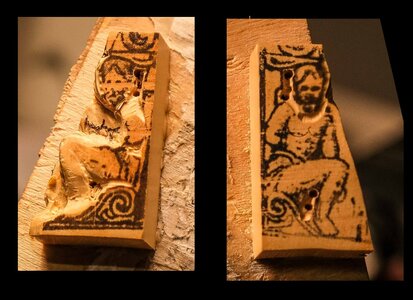
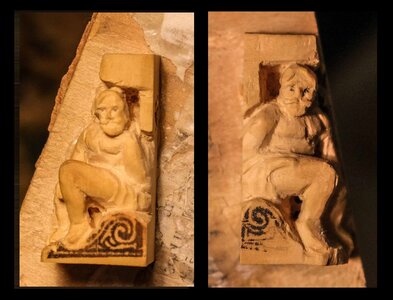
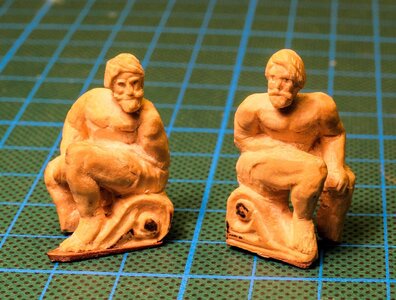
The stern looks like this in a first adjustment test. Small structural carvings that adequately fill the space between the heads and the ship's body are still missing.
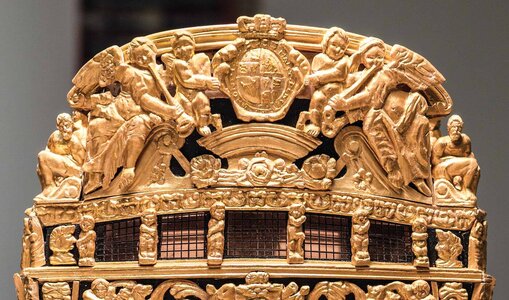
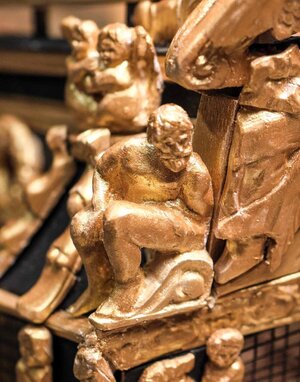
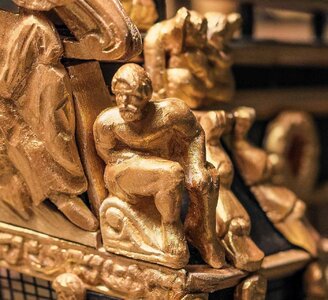
Regards Alexander
Then I carved them out of boxwood. Here are a few pictures of the "making of":



The stern looks like this in a first adjustment test. Small structural carvings that adequately fill the space between the heads and the ship's body are still missing.



Regards Alexander
Brilliant.
- Joined
- Apr 20, 2020
- Messages
- 5,167
- Points
- 738

Wow, very impressive carvingI made the two figures at the corners of the stern as an enlarged plasticine model. That way I could get an idea of how the legs and arms need to be arranged to match the plans and photos.
Then I carved them out of boxwood. Here are a few pictures of the "making of":
View attachment 389761
View attachment 389762
View attachment 389763
The stern looks like this in a first adjustment test. Small structural carvings that adequately fill the space between the heads and the ship's body are still missing.
View attachment 389764
View attachment 389765
View attachment 389766
Regards Alexander

Impressive Alexander, se becomes a stunning beauty.
- Joined
- Apr 10, 2019
- Messages
- 198
- Points
- 253

Hi Alexander, absolutely great. The complete stern looks perfekt
Best regards
Willi (schifferlbauer)
Best regards
Willi (schifferlbauer)
Very good work - Bravo my friend
Hello friends
Not much has happened lately. There were too many other topics.
I actually wanted to turn the cannons on the quarterdeck myself but apparently my lathe has a problem. The support has too much leeway and so after the first 3 copies have been completed no further copies can be made. So I purchased 10 Amati cannons and installed them first. I actually really like them, but the muzzle doesn't match the original.
As in the original, the carriages are simple box examples. No trunnions.
Maybe everything will stay like this and only the cannons will be fine-tuned once the paint is dry.
Then the question is whether I buy a new lathe. That depends on which other projects follow
Unfortunately, the question about the showcase is also open again.
So there are still a few points that need to be clarified. I may also re-carve two reliefs of the stern.
Cheers, Alexander
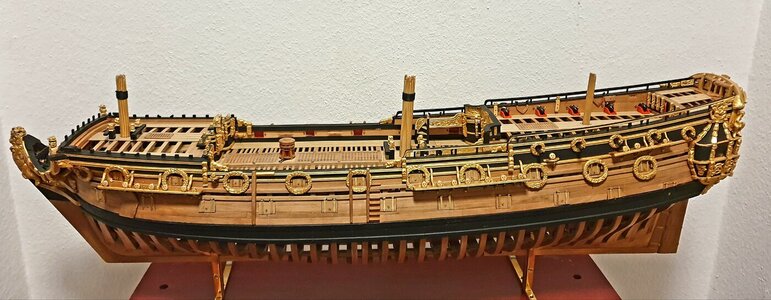
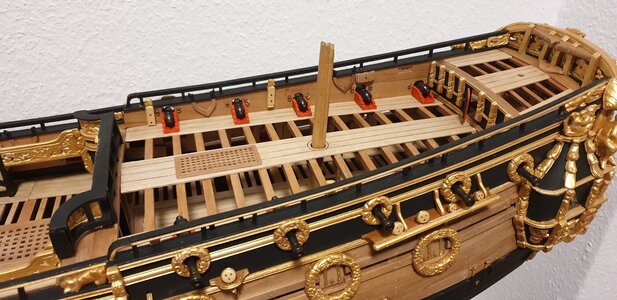
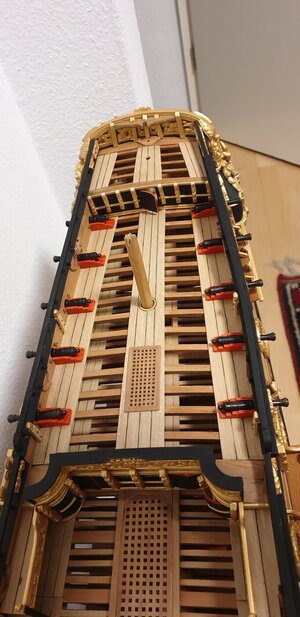
Not much has happened lately. There were too many other topics.
I actually wanted to turn the cannons on the quarterdeck myself but apparently my lathe has a problem. The support has too much leeway and so after the first 3 copies have been completed no further copies can be made. So I purchased 10 Amati cannons and installed them first. I actually really like them, but the muzzle doesn't match the original.
As in the original, the carriages are simple box examples. No trunnions.
Maybe everything will stay like this and only the cannons will be fine-tuned once the paint is dry.
Then the question is whether I buy a new lathe. That depends on which other projects follow
Unfortunately, the question about the showcase is also open again.
So there are still a few points that need to be clarified. I may also re-carve two reliefs of the stern.
Cheers, Alexander



einfach schön
so I guess there will be a new tool / lathe in short time arriving in your workshop - maybe as an early christmas present
so I guess there will be a new tool / lathe in short time arriving in your workshop - maybe as an early christmas present
Then I took care of the two reliefs at the stern.
This is what they look like on the left and right of the stern of the original model:
 -------------------------------------------------- --------------------
-------------------------------------------------- --------------------
This was my first attempt, which was based on the plan drawing:

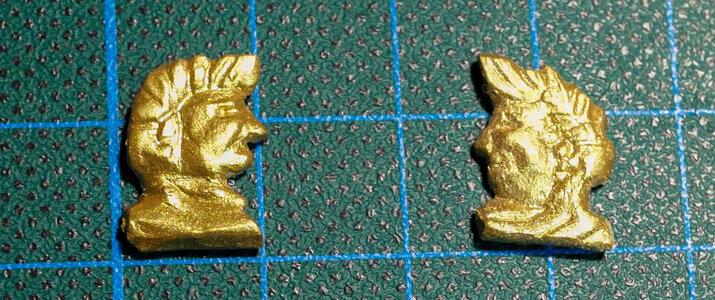
-------------------------------------------------- --------------------
And this is now the second attempt. Here I created a high-contrast template from the photo, which I then ironed onto the wood. The resulting carving is now more like the original, I'm sure you'll agree.
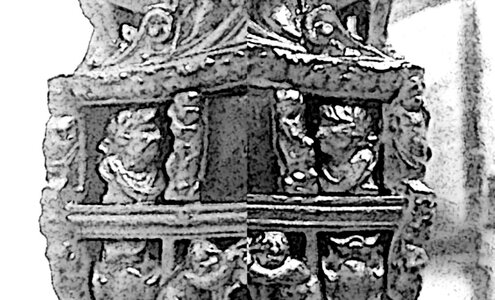
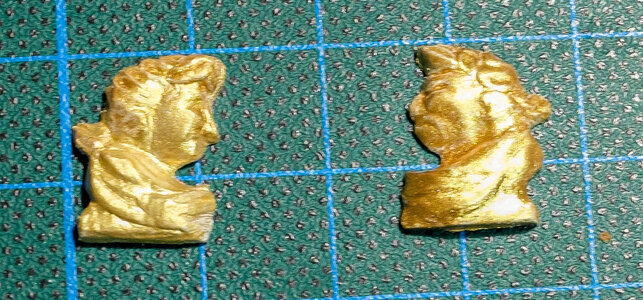
So it's not such a bad idea to use the original pictures as a carving template. Now I'm much more satisfied with the stern and I have decided that the model is finished now.
After about half a year of preparation (research in London and drawing of the frames)
The effective construction time was just under 5 years.
The model now weighs a whopping 3 kilos!
I had a lot of fun building it and I would like to thank you for your interest and the diverse motivation I received from you.
Now I'm taking a creative break. Busy myself with a few other necessary things. But I'm sure things will continue here in the forum.
Best regards, Alexander
This is what they look like on the left and right of the stern of the original model:
 -------------------------------------------------- --------------------
-------------------------------------------------- --------------------This was my first attempt, which was based on the plan drawing:


-------------------------------------------------- --------------------
And this is now the second attempt. Here I created a high-contrast template from the photo, which I then ironed onto the wood. The resulting carving is now more like the original, I'm sure you'll agree.


So it's not such a bad idea to use the original pictures as a carving template. Now I'm much more satisfied with the stern and I have decided that the model is finished now.
After about half a year of preparation (research in London and drawing of the frames)
The effective construction time was just under 5 years.
The model now weighs a whopping 3 kilos!
I had a lot of fun building it and I would like to thank you for your interest and the diverse motivation I received from you.
Now I'm taking a creative break. Busy myself with a few other necessary things. But I'm sure things will continue here in the forum.
Best regards, Alexander
Congratulations on finishing your outstanding model of the St Albans.
This beauty deserves a nice display case.
Enjoy your break. I hope to see you back here with a new challenge.
This beauty deserves a nice display case.
Enjoy your break. I hope to see you back here with a new challenge.
With my replica I wanted to stay close to the original model - without considering its historical accuracy. Navy board models, especially the older ones, were more or less stylized. They therefore did not correspond in every detail to the exemplary ships of the time. They have also been significantly changed through restorations over the centuries. So I suspect that the model of the Saint Albans was originally rigged and the bulwarks were painted green on the outside.
Regardless, I relied on the plans and the photos taken in London.
Many things had to be rethought and developed. The common methods for frame construction from the extensive model building literature could only be used to a limited extent. But that’s what made the work so interesting. Sometimes I felt like a detective on the trail of the old model makers and had many a sense of success when the things I had thought about actually worked. Robert Spence must have felt the same way when he created his replica.
However, the creation of the carvings was definitely disillusioning. Even though I was pleased with my results, as they were far above my previous level, I couldn't hold a candle to the top performances of the carvers at former time.
Maybe that's the motivation to try again with the next model.
Further information and plans for Saint Albans can be found in Richard Endsor's book: "The Master Shipwright's Secrets - How Charles II built the Restoration Navy" from 2020.
At last some pictures of the finished model:
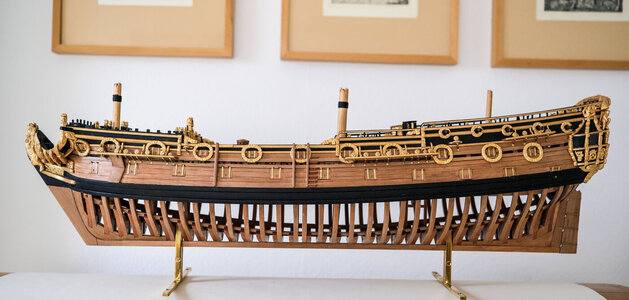
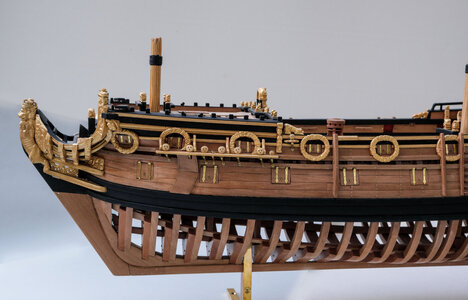
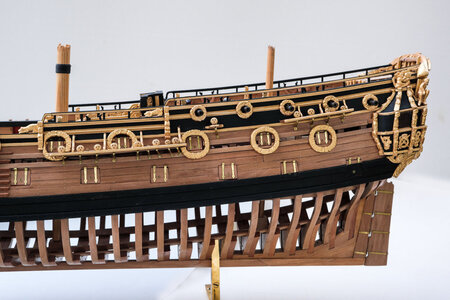
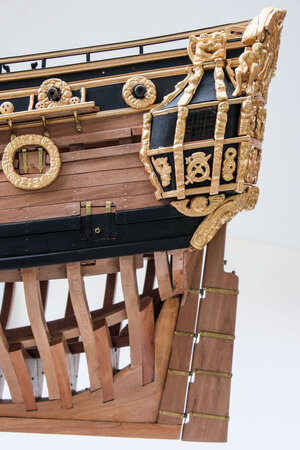
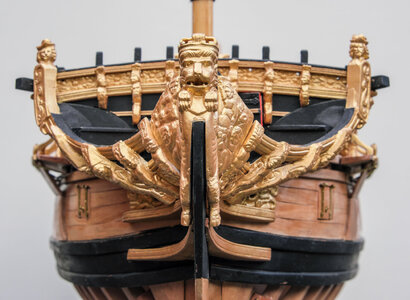
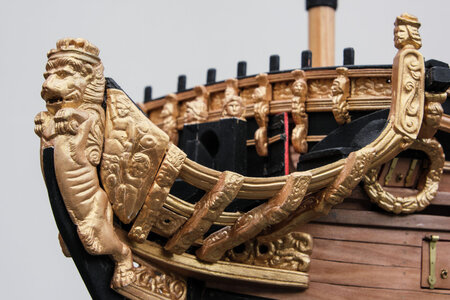
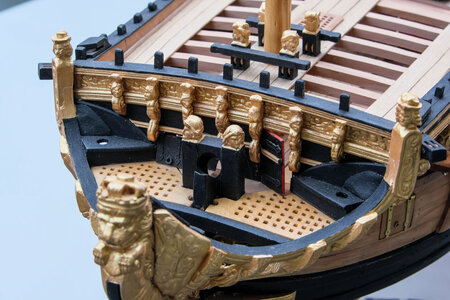
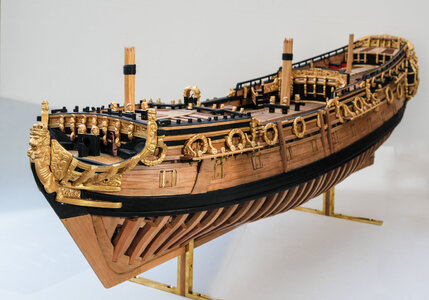
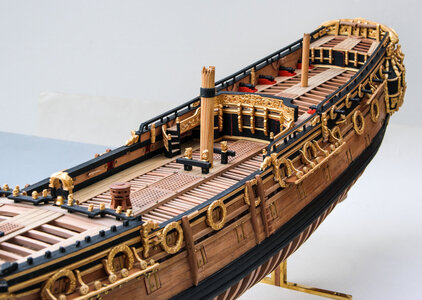
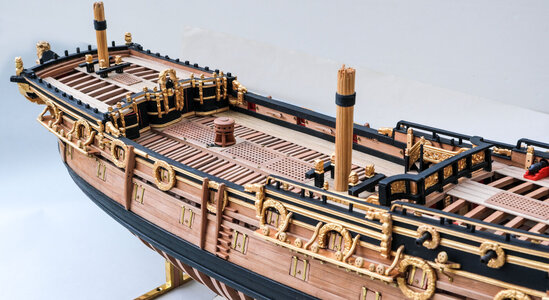
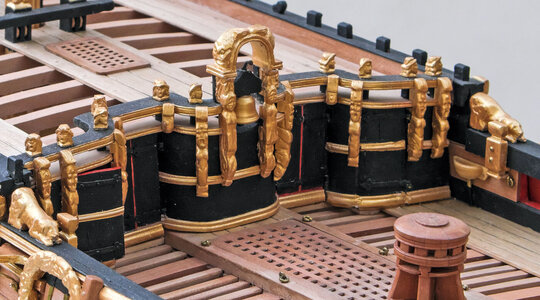
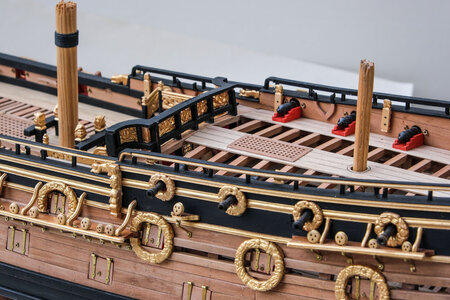
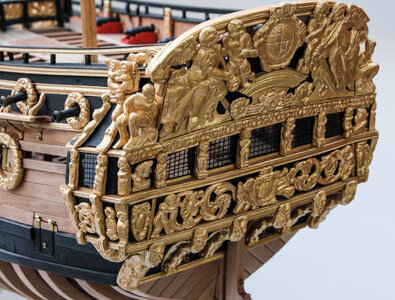
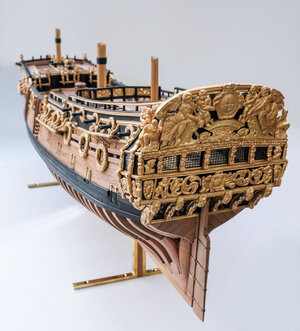
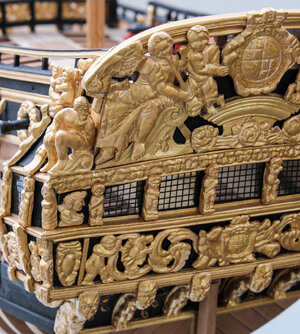
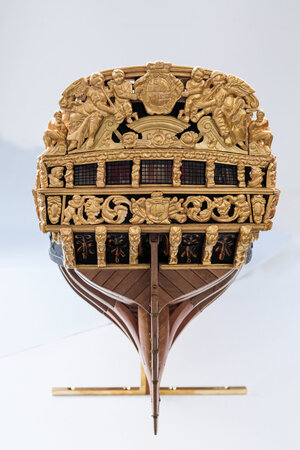
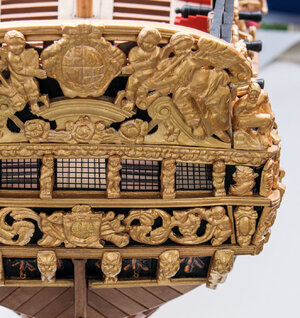
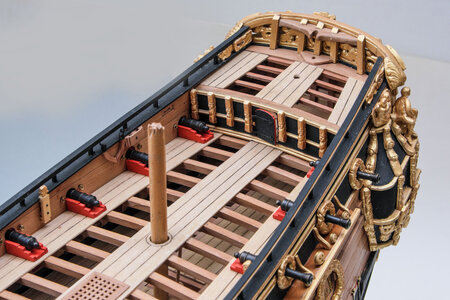
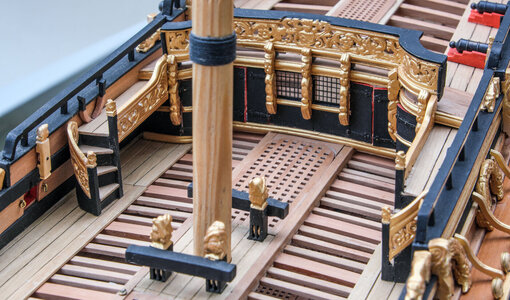
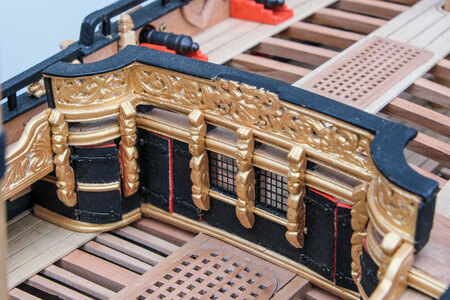
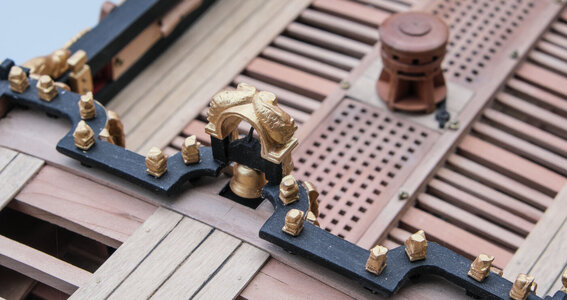
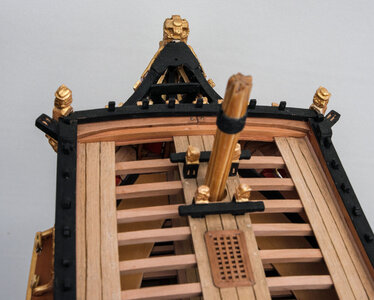
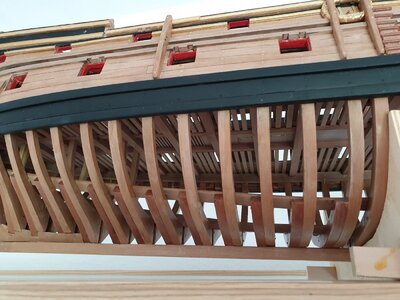
Regardless, I relied on the plans and the photos taken in London.
Many things had to be rethought and developed. The common methods for frame construction from the extensive model building literature could only be used to a limited extent. But that’s what made the work so interesting. Sometimes I felt like a detective on the trail of the old model makers and had many a sense of success when the things I had thought about actually worked. Robert Spence must have felt the same way when he created his replica.
However, the creation of the carvings was definitely disillusioning. Even though I was pleased with my results, as they were far above my previous level, I couldn't hold a candle to the top performances of the carvers at former time.
Maybe that's the motivation to try again with the next model.
Further information and plans for Saint Albans can be found in Richard Endsor's book: "The Master Shipwright's Secrets - How Charles II built the Restoration Navy" from 2020.
At last some pictures of the finished model:























Last edited:
Absolutely fantastic work Alexander, I would like to congratulate you on the completion and enjoy your break.
Congratulations on a very good model, Alexandr!!
Also from my side my CONGRATULATIONS for finishing your amazing model
Do not make a too long break - I will miss your information and photos of the progress
I am looking forward
Do not make a too long break - I will miss your information and photos of the progress
I am looking forward
Magnificent Alexander! I know you will display her with pride in the place of honor.
- Joined
- Apr 20, 2020
- Messages
- 5,167
- Points
- 738

Dear AlexanderWith my replica I wanted to stay close to the original model - without considering its historical accuracy. Navy board models, especially the older ones, were more or less stylized. They therefore did not correspond in every detail to the exemplary ships of the time. They have also been significantly changed through restorations over the centuries. So I suspect that the model of the Saint Albans was originally rigged and the bulwarks were painted green on the outside.
Regardless, I relied on the plans and the photos taken in London.
Many things had to be rethought and developed. The common methods for frame construction from the extensive model building literature could only be used to a limited extent. But that’s what made the work so interesting. Sometimes I felt like a detective on the trail of the old model makers and had many a sense of success when the things I had thought about actually worked. Robert Spence must have felt the same way when he created his replica.
However, the creation of the carvings was definitely disillusioning. Even though I was pleased with my results, as they were far above my previous level, I couldn't hold a candle to the top performances of the carvers at former time.
Maybe that's the motivation to try again with the next model.
Further information and plans for Saint Albans can be found in Richard Endsor's book: "The Master Shipwright's Secrets - How Charles II built the Restoration Navy" from 2020.
At last some pictures of the finished model:
View attachment 405540View attachment 405541View attachment 405542View attachment 405543View attachment 405544View attachment 405545View attachment 405546View attachment 405547View attachment 405548View attachment 405549View attachment 405550View attachment 405551View attachment 405552View attachment 405553View attachment 405554View attachment 405555View attachment 405556View attachment 405557View attachment 405558View attachment 405559View attachment 405560View attachment 405561
View attachment 405563
you have created a wonderful model, it's a great pleasure to watch the song and also the impressive result. Enjoy your vacation/break





